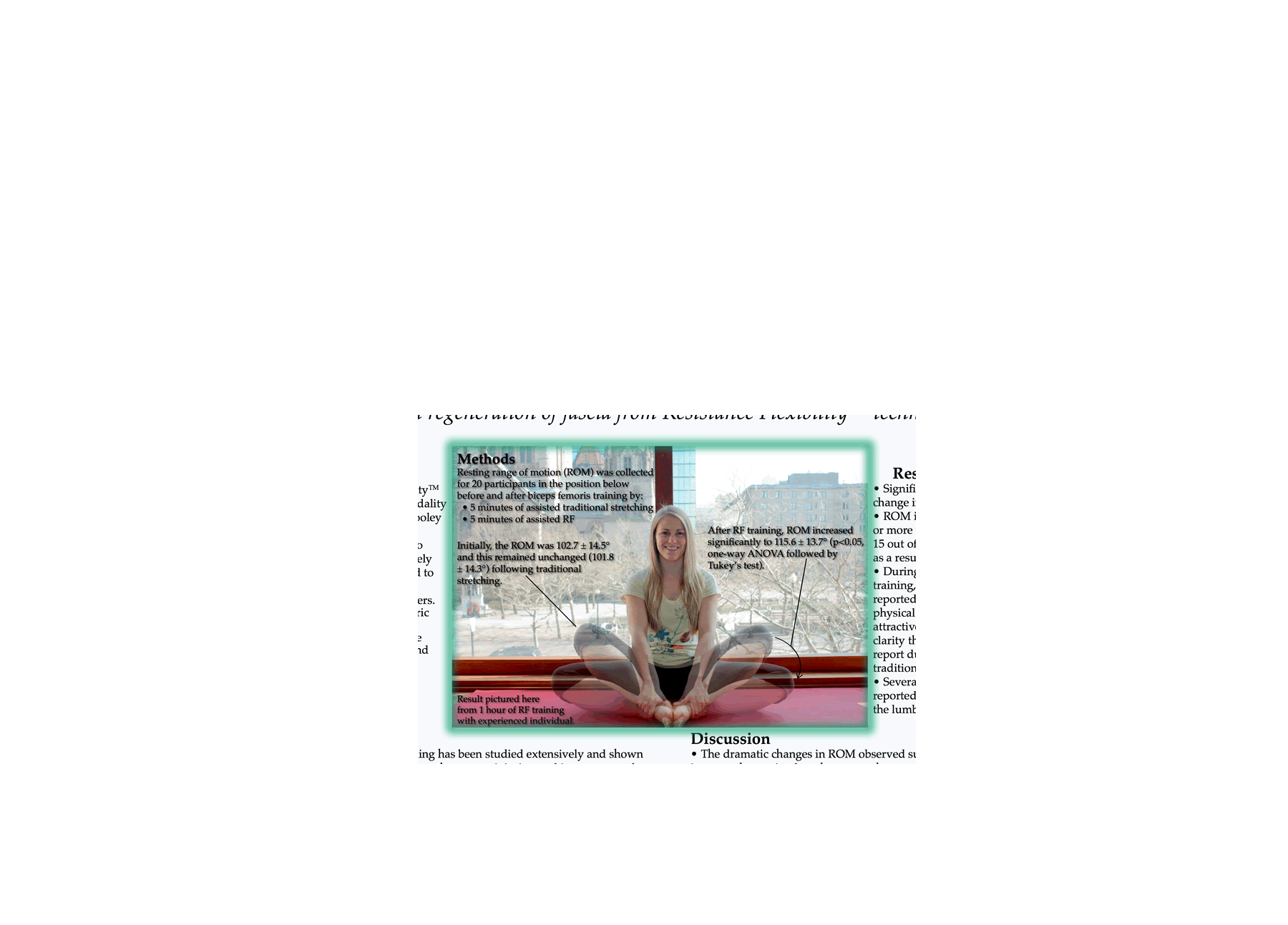Bob Cooley and Nick Ware's poster presentation at the 2012 International Fascia Congress in Vancouver, BC
select images to play/enlarge...
Introduction
- Resistance Flexibility (RF) is a physical modality developed by Bob Cooley in Boston, MA.
- RF has been used to rehabilitate the severely injured/diseased and to upgrade world-class athletes and performers.
- RF involves eccentric force loading and produces quantifiable changes in posture and range of motion in minutes.
- RF is a zero-pain technique.
Methods
Resting range of motion (ROM) was collected for 20 participants in the position below before and after biceps femoris training by:
- 5 minutes of assisted traditional stretching
- 5 minutes of assisted RF
Initially, the ROM was 102.7 ± 14.5° and this remained unchanged (101.8 ± 14.3°) following traditional stretching.
After RF training, ROM increased significantly to 115.6 ± 13.7° (p < 0.05, one-way ANOVA followed by Tukey's test).
Result pictured here from 1 hour of RF training with experienced individual.
Results
- Significant, dramatic change in ROM.
- ROM increase of 10.0° or more was observed in 15 out of 20 participants as a result of RF training.
- During and after RF training, participants reported feelings of physical comfort, lightness, attractiveness, and mental clarity that they did not report during or after traditional stretching.
- Several participants reported relief of pain in the lumbar spine.
Concepts
- Eccentric force loading has been studied extensively and shown to increase muscle strength, prevent injuries, and increase muscle flexibility.
- RF eliminates pain in the body and causes uncharacteristically rapid range of motion and flexibility increases.
- Current models of myofascial change cannot explain the rapid flexibility increases that RF causes.
- Changing damaged fascia in a muscle increases its flexibility and its capacity to shorten.
Discussion
- The dramatic changes in ROM observed suggest that RF training increases hamstring length at an uncharacteristically fast rate.
- Endoscopic filming of fascia during RF with Dr. JC Guimberteau revealed fibrillar movement and the verticalization of fibers.
- RF training may restore fascia by affecting its tension and microvacuolar volume.
- Future studies are required to quantify RF effects on other muscles and the mechanism by which RF may restore fascia to a healthier state.
- Related studies in progress include RF low back pain clinical trial in Mumbai and ultrasound quantification of RF changes.
For more information on the Elite Training Program, please contact us.
We would like to thank Dr. Jean-Claude Guimberteau for his endoscopic filming and Dr. Kris Kruse-Elliot for her help with statistical analysis of the data.
Does Resistance Flexibility™ result in rapid hamstring length increases and accelerated range of motion increases because of fascial changes?
Robert D. Cooley and Nicholas M. WareThe Genius of Flexibility Center, 561 Boylston St, 2nd Floor, Boston, MA 02144
phone: 617-955-5416 email: This email address is being protected from spambots. You need JavaScript enabled to view it.
BACKGROUND Eccentric force loading exercises have been shown to cause increased muscle strength, demand less oxygen than concentric strength training [1], prevent injuries, and effectively treat tendinopathy [2]. The physics and pathophysiology of eccentric force loading and its beneficial effects are poorly understood. We introduce the hypothesis that Resistance Flexibility™ (RF) eccentric force technology and biomechanical analysis method immediately affects fascia, resulting in uncharacteristically rapid range of motion increases and specifically increased flexibility of the hamstrings and the antagonist or 'balancing muscle.' RF is a zero-pain technology designed to identify damaged fascia in the body and then rehydrate and remodel this fascia. Anecdotally, RF training eliminates pain in the body and causes increased flexibility, strength, and range of motion [3].
METHODS 1) Range of Motion: We measured maximum resting range of motion in 20 participants seated in a modified lotus position with a handheld goniometer/dynamometer: a) before training, b) after 5 minutes of traditional stretching on the lateral hamstrings, and c) after 5 minutes of RF training on the lateral hamstrings. 2) Stride Length: We measured stride length before and after 20 minutes of RF lower body training on 9 participants using the Tekscan Walkway™ gait analysis system. 3) Endoscopic Filming: We filmed the effect of RF training endoscopically in collaboration with Dr. Jean-Claude Guimberteau.
RESULTS 1) Range of Motion: Range of motion measured before and after traditional stretching and after RF training (n=20) showed the following changes (mean +/- SEM): After traditional stretching, the range of motion remained approximately the same at 101.8 +/- 14.3° from the pre-training 102.7 +/- 14.5°; after RF training, range of motion increased to 115.6 +/- 13.7°. RF training produced a significantly greater range of motion (p<0.05) than no treatment or traditional stretching (one-way ANOVA with post-hoc TUKEY test). A range of motion increase of 10.0° or more was observed in 15 out of 20 participants as a result of RF training. These results indicate there was no significant change in range of motion in response to traditional stretching, and a dramatic and significant increase in range of motion in response to RF training. During and after RF training, participants reported feelings of physical comfort, lightness, attractiveness, and mental clarity that they did not report during or after traditional stretching. Several participants reported relief of pain in the lumbar spine.
2) Stride Length: Gait analysis before and after RF training (n=9) revealed the following change (mean +/- SEM): Stride length increased to 731.1+27.1 mm from the pre-training 678.6+38.2 mm in response to RF training. These preliminary results indicate an increase in stride length in response to RF training.
3) Endoscopic Filming: RF training produced fibrillar movement and the verticalization of fibers in fascia that traditional stretching and strength training did not produce.
CONCLUSIONS The rapid range of motion increase caused by RF training corresponds to the RF principle that changing damaged fascia in a given muscle increases its flexibility and the flexibility of the antagonist or 'balancing muscle.' The effectiveness of this principle and the rapid changes observed in this study are not explainable by current models of myofascial change. The observed increase in stride length following RF training suggests that RF increases hamstring length at an uncharacteristically fast rate. Stride length has been shown to increase in patients that undergo surgical lengthening of the hamstrings and is commonly used as a measure of hamstring function [4]. The fascial changes caused by RF are remarkable in the context of flexibility training and current physical evidence of fascial change, and suggest that RF training may restore fascia by affecting its tension and microvacuolar volume. Further studies are required to investigate how RF may restore fascia to healthier state, to quantify the effects of RF on other muscle groups.
REFERENCES [1] P. C. LaStayo et al. Chronic eccentric exercise: improvements in muscle strength can occur with little demand for oxygen. Am J Phy, 1999;276:R611-615. [2] M. R. Pull, C. Ranson. Eccentric muscle actions: Implications for injury, prevention, and rehabilitation. Phy Ther Sport, 2007, 88-97. [3] R.D. Cooley. The Genius of Flexibility. Simon and Schuster, 2005. [4] Interrelationships of Strength and Gait Before and After Hamstring Lengthening. J Ped Ortho, 1999;19(3):352-358.
DISCLOSURE This research was supported by The Genius of Flexibility Institute. We would like to thank Dr. Jean-Claude Guimberteau for his endoscopic filming of RF training. We would like to thank Marshall Kendall and Tekscan, Inc. for their assistance with stride length data collection. We would also like to thank Dr. Kris Kruse-Elliott for her help with analysis of the data.












